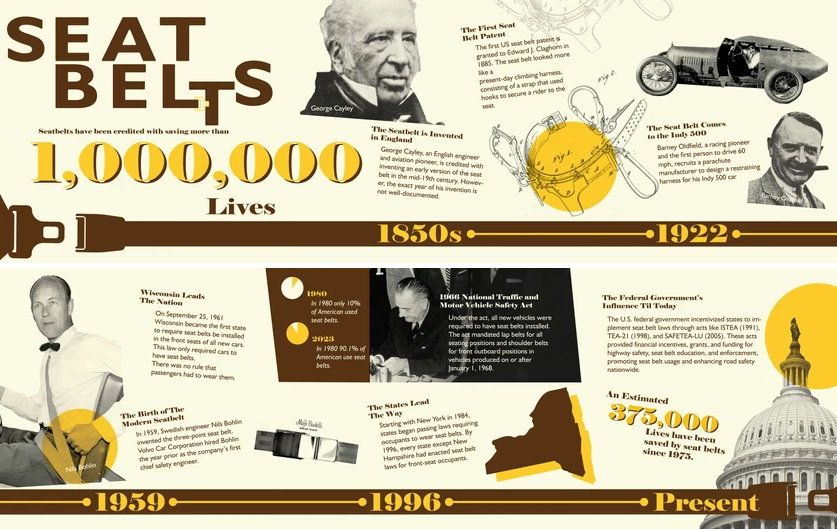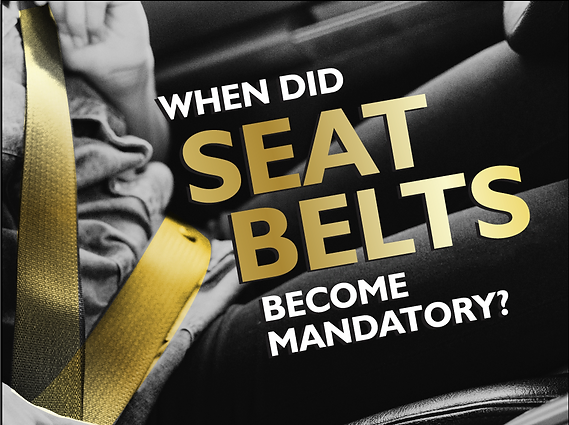You may remember from a young age that your parents always said the first thing you do when you get in a car is put on your seatbelt. This of course was for safety purposes but did you know that not only were seat belt laws not in place but sometimes cars didn’t even have seat belts built in?
In fact, it wasn’t until the 1980s, that about 10% of America was active in the practice of seat belt use. Laws, technological advancements, and education were a big part of what made people more open to part taking in this practice and understanding they would be penalized if they did not.
The knowledge we have on how seatbelts can save lives has changed the way in which people view seatbelts. Seatbelts over the past few years have saved more than one million lives. Yet you may be wondering beyond that what was the evolution or how did the invention come to be? In this article, we will outline the timeline as to how and when seatbelts became mandatory as well as how they were invented.

It all started in the mid-1800s…
The first seatbelt was invented by Sir George Cayley, a wealthy landowner in Yorkshire. Cayley was interested in aerodynamics and the principles of flight but he invented a safety device that would change the safety of these vehicles.
He had built the first successful manned glider, a half-century before Orville and Wilbur Wright created the airplane. It was inside this aircraft that Cayley included a lap belt to keep the pilot in place. (i.e. the first seatbelt)
His first test flight had crash-landed et due to the lap bar, but the pilot survived.
The first seat belt patent was granted in 1885
On February 10, New York City resident Edward J. Claghorn was given the first patent for a car seat belt.
He had made it to protect tourists when they rode in taxis. His version of the seat belt looked like a climbing harness, consisting of a strap that used hooks to secure you to the seat.
The Seat Belt Comes to the Indy 500 in 1922
The first belt was brought to the Indy 500 by Barney Oldfield, the first man to drive about 60 mph. He asked a manufacturer to create a harness to restrain him in his Indy Car. He asked for this because he has seen so many drivers get hurt, die, or get ejected from their vehicles.
Surprisingly Oldfield’s request was one of the first for the Indy 500 races because before this date seat belts were rarely worn.
The thought behind why people were hesitant to wear seat belts is believed to have stemmed from a myth such as one that claimed it was safer to be flung from your car rather than to remain inside as it crashed and possibly burned.
While people believed these outrageous myths, manufacturers seemed to think cars already had too many safety features. They thought that by adding more they made it seem as though they were giving the impression that their vehicle was unsafe.
The Three-Point Seat Belt Is Invented in 1959
The invention of the three-point seatbelt was probably one of the most pivotal points in the seatbelt overall evolution. Volvo Car Corporation hired a Swedish engineer by the name of Nils Bohlin to be the company’s Chief safety engineer.
It was here that Bohlin discovered that a two-point seatbelt only secured the passenger’s lap and that a four-point seatbelt was unattainable for cars. It was there that he came up with the solution that a three-point seatbelt was the best option. This ensured that both the upper and lower region of an individual was restrained and secure.
The first car to feature Bohlin’s three-point seat belt invention was the Volvo PV544, but others followed that trend shortly after. The significant impact of this invention went beyond just its creation because Volvo openly shared this invention with other manufacturers freely thus making seatbelts a staple item in most vehicles.
When Bohlin passed, Volvo released a study that his three-point seat belt invention had actually saved more than one million lives.
In 1961 you had to wear a seatbelt in Wisconsin, it was MANDATORY
The first state to require seatbelts in its vehicles was Wisconsin. This seat belt law only required vehicles to have seatbelts installed in vehicles and in no way mandated passengers to wear seat belts.
The step in the right direction for seat belts… they became nationally mandated
The first nationally regarded seat belt law mandated that all new cars be equipped with both lap and shoulder belts in the front part of the vehicle. Although the three-point seat belt had been around for nearly a decade, the law did not specify the need for any particular design. This resulted in many manufacturers providing separate lap belts.
The seat belt interlock mechanism is introduced
It wasn’t until 1973 that the National Highway Traffic Safety Administration required all new cars to feature this interlocking seat belt mechanism. This device prevented cars from starting until the driver’s seat belt was buckled.
A lot of individuals found this device to be intrusive and infringe upon people’s free will, yet the mandate did not change. It wasn’t until the auto industry also stated their issues with this mandate that changes were made, they too did not like the device as it added to the overall cost of the vehicle. Congress ended up nixing the mandate as a response.
The seat belt issue goes to the Supreme Court
This case dates back to 1977, right after the almighty interlocking device got denied, The NHTSA created a new rule stating that car manufacturers must include a restraint that worked to protect passengers in a vehicle driving 35 mph if it hit a wall.
This needed inclusion was then mandated and in the 1980s the presidential election continued to change matters. Ronald Regan ran his campaign on de-regulation and opposed the law that forced manufacturers to include these restraints in their vehicles. Thus yet again the requirement got revoked.
While all hope seemed to be lost on the seatbelt, insurance companies started to put their two cents into the mix. Since they had a vested interest in passenger safety they sued the administration.
This is where the Supreme Court got involved they voted unanimously in favor of the insurance companies. They then ordered the Department of Transportation to reinstate the requirement.
New York state requires front-seat passengers to wear seat belts
New York state created its seat belt law that went into effect on Jan. 1, 1985. This law required just the front seat passengers to wear a seat belt. If they did not do so then they were fined $50.
As time passed the law also required passengers 16 and older to wear a seat belt in the back seats of the car.
These rules are now nationwide and everyone that enters a car is required to wear a seat belt. This mandatory seatbelt law has made 92% of all Americans utilize the seatbelt. There is one state that does not require seat belt usage and that is New Hampshire, thus why the percentage is only 92%. The seatbelt has saved numerous lives in the US, an estimated amount of about 15,000 lives a year to be more exact.
So why is it important to wear seat belts?
As you can see from history and the facts we have presented thus far in the article making mandatory seat belt laws in most states have changed the level of safety an individual has in a vehicle. While the task of putting it on may seem like an annoyance it’s life-saving. Here are some points you may want to keep in mind when you are thinking about whether or not to put on a seatbelt.
1. It holds you in place
If you think this is a negative thing it’s actually not, when a car goes through a car accident it is hit by a tremendous force. That means that being belted in will help prevent more serious personal injuries. It also stops you from being thrown out of your vehicle.
2. It will protect your passengers
During a crash, your passenger if not properly secured could move around the vehicle. This increases your chances of injury. It is not always possible to avoid an injury as a result of an external impact or roll but by wearing a seat belt, you can greatly improve your chances of staying safe.
3. It is more likely to help your airbag save you
For you to be fully protected in a car there are other safety devices that in partnership with your seatbelt keep you safe. One of those features is the airbag, while you can’t solely depend on one or another you fully need the support of both.
It’s important to note if you are not wearing a seatbelt and you do experience a car accident your airbags are not as effective.
4. It will help you avoid legal issues
If the safety benefits aren’t enough to persuade you to buckle up, the threat of legal consequences should be. Since all states except New Hampshire have mandatory seat belt laws, you do not want to run into a situation.
The resulting consequence could be anywhere from a hefty fine to a traffic violation on your record.
5. It will reduce your insurance cost
If you drive without a seat belt and get ticketed or fined, your insurance company will be notified. This can lead to them having suspicion about your driving habits, thus making your rates higher.
In the event of an accident, going without a seat belt could even result in you losing your insurance coverage. Your provider may even deny your claim and refuse to pay for your damages.
6. It will strengthen your personal injury case
If you’ve been hurt in an accident that wasn’t your fault, you can file a personal injury claim with the help of a personal injury lawyer. Unfortunately, if you were not wearing your seatbelt at the time of the accident, your case will be difficult to prove even if fault is established.
In this case, the opposing legal team will probably argue that your injuries were caused or exacerbated by your lack of a seat belt.
7. Bonus: No beeping noise
When you enter any car today they will insistently beep until you have put on a seatbelt. If you decide not to wear a seatbelt, the beeping will continue. So just put the seatbelt on it’s for your safety and it will stop making your car seem so annoying.
What should I do if I was wearing my seat belt but I got into an accident and sustained an injury?
While seatbelts will help protect you, they are not a surefire way to know that you won’t get injured. What the seatbelt does do is prevent a more serious injury or possibly even death. While it may seem like an annoyance it is extremely important to do so.
If you or a loved one does get injured after an accident call the personal injury lawyers that care about getting you the compensation you deserve. The reason we shared the history of how seatbelts came to be and the mandatory seat belt laws is that we believe it is our responsibility to help ensure our community is safe. From our experience seat belts save lives and we want to make sure in the event of an accident you are as protected as you can be.
Call us today for your free consultation at 866-954-MORE (6673), and we will help you gain the compensation you deserve.



